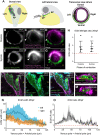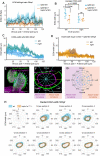Asymmetric Hapln1a drives regionalized cardiac ECM expansion and promotes heart morphogenesis in zebrafish development
- PMID: 33616638
- PMCID: PMC8752364
- DOI: 10.1093/cvr/cvab004
Asymmetric Hapln1a drives regionalized cardiac ECM expansion and promotes heart morphogenesis in zebrafish development
Abstract
Aims: Vertebrate heart development requires the complex morphogenesis of a linear tube to form the mature organ, a process essential for correct cardiac form and function, requiring coordination of embryonic laterality, cardiac growth, and regionalized cellular changes. While previous studies have demonstrated broad requirements for extracellular matrix (ECM) components in cardiac morphogenesis, we hypothesized that ECM regionalization may fine tune cardiac shape during heart development.
Methods and results: Using live in vivo light sheet imaging of zebrafish embryos, we describe a left-sided expansion of the ECM between the myocardium and endocardium prior to the onset of heart looping and chamber ballooning. Analysis using an ECM sensor revealed the cardiac ECM is further regionalized along the atrioventricular axis. Spatial transcriptomic analysis of gene expression in the heart tube identified candidate genes that may drive ECM expansion. This approach identified regionalized expression of hapln1a, encoding an ECM cross-linking protein. Validation of transcriptomic data by in situ hybridization confirmed regionalized hapln1a expression in the heart, with highest levels of expression in the future atrium and on the left side of the tube, overlapping with the observed ECM expansion. Analysis of CRISPR-Cas9-generated hapln1a mutants revealed a reduction in atrial size and reduced chamber ballooning. Loss-of-function analysis demonstrated that ECM expansion is dependent upon Hapln1a, together supporting a role for Hapln1a in regionalized ECM modulation and cardiac morphogenesis. Analysis of hapln1a expression in zebrafish mutants with randomized or absent embryonic left-right asymmetry revealed that laterality cues position hapln1a-expressing cells asymmetrically in the left side of the heart tube.
Conclusion: We identify a regionalized ECM expansion in the heart tube which promotes correct heart development, and propose a novel model whereby embryonic laterality cues orient the axis of ECM asymmetry in the heart, suggesting these two pathways interact to promote robust cardiac morphogenesis.
Keywords: Extracellular matrix; Heart development; Heart morphogenesis; Laterality; Zebrafish.
© The Author(s) 2021. Published by Oxford University Press on behalf of the European Society of Cardiology.
Figures








Similar articles
-
Cx43-Dependent Skeletal Phenotypes Are Mediated by Interactions between the Hapln1a-ECM and Sema3d during Fin Regeneration.PLoS One. 2016 Feb 1;11(2):e0148202. doi: 10.1371/journal.pone.0148202. eCollection 2016. PLoS One. 2016. PMID: 26828861 Free PMC article.
-
Left-right asymmetric heart jogging increases the robustness of dextral heart looping in zebrafish.Dev Biol. 2020 Mar 15;459(2):79-86. doi: 10.1016/j.ydbio.2019.11.012. Epub 2019 Nov 20. Dev Biol. 2020. PMID: 31758943
-
morphoHeart: A quantitative tool for integrated 3D morphometric analyses of heart and ECM during embryonic development.PLoS Biol. 2025 Jan 29;23(1):e3002995. doi: 10.1371/journal.pbio.3002995. eCollection 2025 Jan. PLoS Biol. 2025. PMID: 39879226 Free PMC article.
-
Recent advances in the study of zebrafish extracellular matrix proteins.Dev Biol. 2015 May 1;401(1):110-21. doi: 10.1016/j.ydbio.2014.12.022. Epub 2014 Dec 29. Dev Biol. 2015. PMID: 25553981 Review.
-
Shaping the zebrafish heart: from left-right axis specification to epithelial tissue morphogenesis.Dev Biol. 2009 Jun 15;330(2):213-20. doi: 10.1016/j.ydbio.2009.04.011. Epub 2009 Apr 14. Dev Biol. 2009. PMID: 19371733 Review.
Cited by
-
Mechanical forces remodel the cardiac extracellular matrix during zebrafish development.Development. 2024 Jul 1;151(13):dev202310. doi: 10.1242/dev.202310. Epub 2024 Jul 10. Development. 2024. PMID: 38984541 Free PMC article.
-
Hapln1 promotes dedifferentiation and proliferation of iPSC-derived cardiomyocytes by promoting versican-based GDF11 trapping.J Pharm Anal. 2024 Mar;14(3):335-347. doi: 10.1016/j.jpha.2023.09.013. Epub 2023 Sep 22. J Pharm Anal. 2024. PMID: 38618242 Free PMC article.
-
Clinical and translational values of spatial transcriptomics.Signal Transduct Target Ther. 2022 Apr 1;7(1):111. doi: 10.1038/s41392-022-00960-w. Signal Transduct Target Ther. 2022. PMID: 35365599 Free PMC article. Review.
-
Rescue of mitochondrial dysfunction through alteration of extracellular matrix composition in barth syndrome cardiac fibroblasts.Biomaterials. 2025 Apr;315:122922. doi: 10.1016/j.biomaterials.2024.122922. Epub 2024 Oct 26. Biomaterials. 2025. PMID: 39509858
-
Presence of chondroitin sulphate and requirement for heparan sulphate biosynthesis in the developing zebrafish inner ear.Front Cell Dev Biol. 2022 Aug 26;10:959624. doi: 10.3389/fcell.2022.959624. eCollection 2022. Front Cell Dev Biol. 2022. PMID: 36092694 Free PMC article.
References
-
- Linde D V D, Konings EEM, Slager MA, Witsenburg M, Helbing WA, Takkenberg JJM, Roos-Hesselink JW. Birth prevalence of congenital heart disease worldwide: a systematic review and meta-analysis. J Am Coll Cardiol 2011;58:2241–2247. - PubMed
-
- Desgrange A, Garrec J-FL, Meilhac SM. Left-right asymmetry in heart development and disease: forming the right loop. Development 2018;145:dev162776. - PubMed
-
- Levin M, Johnson RL, Sterna CD, Kuehn M, Tabin C. A molecular pathway determining left-right asymmetry in chick embryogenesis. Cell 1995;82:803–814. - PubMed
-
- Long S, Ahmad N, Rebagliati M. The zebrafish nodal-related gene southpaw is required for visceral and diencephalic left-right asymmetry. Development 2003;130:2303–2316. - PubMed
Publication types
MeSH terms
Substances
Grants and funding
LinkOut - more resources
Full Text Sources
Other Literature Sources
Molecular Biology Databases
Research Materials

